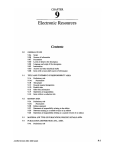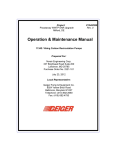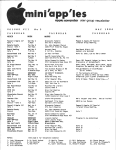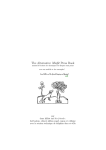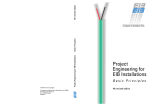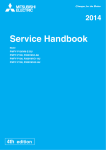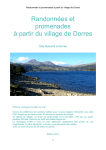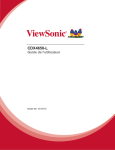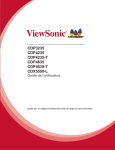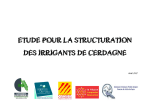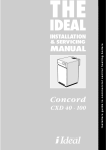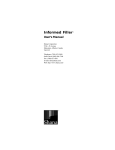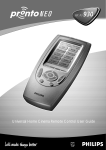Download 4JSC/Amendments/2001/Rev 3 July 2001 To: Joint Steering
Transcript
4JSC/Amendments/2001/Rev 3 July 2001 To: Joint Steering Committee for Revision of AACR From: Ann Huthwaite, Chair, JSC Subject: Review of 2001 revision package Attached is the revised typeset version of the 2001 revision package. It incorporates the changes suggested by the national libraries, with one exception. The publishers have advised that the additional spaces between words on page 32 were not deleted, as these spaces were needed to maintain paragraph justification. The national libraries are asked to make comments on this revision by 10 July 2001, if possible. ANGLO-AMERICAN CATALOGUING RULES Second Edition 1998 Revision AMENDMENTS 2001 Prepared under the direction of THE JOINT STEERING COMMITTEE FOR REVISION OF AACR a committee of: The American Library Association The Australian Committee on Cataloguing The British Library The Canadian Committee on Cataloguing The Library Association The Library of Congress CANADIAN LIBRARY ASSOCIATION / Ottawa LIBRARY ASSOCIATION PUBLISHING / London AMERICAN LIBRARY ASSOCIATION / Chicago 1 NEW AMENDMENTS LIST Following is a list of revisions agreed to by JSC at its San Diego meeting in March 2000 and its London meeting in September 2000. They are now incorporated in the electronic format. Amendments 2001 2 Entry in CONTENTS (p. v) to be changed: Change: 9 Computer Files 220 To: 9 Electronic Resources 220 Amendments 2001 3 New appendix to be added in CONTENTS under Appendices (p. v): E Initial Articles Amendments 2001 4 Rule 0.24 to read: 0.24. It is important to bring out all aspects of the item being described, including its content, its carrier, its type of publication, its bibliographic relationships, and whether it is published or unpublished. In any given area of the description, all relevant aspects should be described. As a rule of thumb, the cataloguer should follow the more specific rules applying to the item being catalogued, whenever they differ from the general rules. Amendments 2001 5 Rule 0.25 to read: 0.25. The ISBD(G) contains an area for details that are special to a particular class of material or type of publication. This third area is used in these rules for cartographic materials (chapter 3), music (chapter 5), electronic resources (chapter 9), serial publications (chapter 12), and, in some circumstances, microforms (chapter 11). Do not use this area for any other materials treated in these rules. Where it is applicable and appropriate, repeat this area. For example, in describing a serial cartographic item or a serial electronic resource, give details relating to the cartographic material or the electronic resource and those relating to its seriality (in that order). Amendments 2001 6 Rule 1.1C1 to read: 1.1C1. Choose one of the lists of general material designations given below and use terms from the chosen list in all descriptions for which general material designations are desired.1 If general material designations are to be used in cataloguing, British agencies should use terms from list 1 and agencies in Australia, Canada, and the United States should use terms from list 2.2 list 1 braille cartographic material electronic resource graphic manuscript microform motion picture multimedia music object sound recording text videorecording list 2 activity card art original art reproduction braille cartographic material chart diorama electronic resource filmstrip flash card game kit manuscript microform microscope slide model motion picture music picture realia slide sound recording technical drawing 1. In all subsequent examples, other than those illustrating general material designations directly, the designation is indicated by [gmd]. The use of [gmd] in examples does not imply that a designation is required. 2. The following rules apply to list 2: 1) Use cartographic material for cartographic charts, not chart. 2) For material treated in chapter 8, use picture for any item not subsumed under one of the other terms in list 2. 3) Use technical drawing for any item fitting the definition of this term in the Glossary, appendix D; for architectural renderings, however, use art original, art reproduction, or picture, not technical drawing. 4) Use kit for any item fitting the definition of this term in the Glossary, appendix D; note that this term may apply to certain categories of textual material. Amendments 2001 7 text toy transparency videorecording For materials for the visually impaired, add (large print) or (tactile), when appropriate, to any term in list 2. Add (braille), when appropriate, to any term in list 2 other than braille or text. . . . [cartographic material (tactile)] . . . [music (braille)] . . . [text (large print)] Amendments 2001 8 Rule 1.1C2 to read: 1.1C2. If an item consists of material falling within one category in the list chosen, give the appropriate designation immediately following the title proper (or the last part of the title proper, see 1.1B9). How the poor view their health [electronic resource] British masters of the albumen print [microform] Divina commedia. Inferno [text] [Remainder of rule remains unchanged.] Amendments 2001 9 Rule 1.1F7 to read: 1.1F7. Include titles and abbreviations of titles of nobility, address, honour, and distinction, initials of societies, qualifications, date(s) of founding, mottoes, etc., in statements of responsibility if: a) such data are necessary grammatically . . . / . . . ; prólogo del Excmo. Sr. D. Manuel Fraga Iribarne b) the omission would leave only a person’s given name or surname . . . / by Miss Jane . . . / by Miss Read . . . / by Dr. Johnson . . . / by the Baroness Orczy c) the title is necessary to identify a person . . . / by Mrs. Charles H. Gibson d) the title is a title of nobility, or is a British term of honour (Sir, Dame, Lord, or Lady). . . . / Anne Finch, Countess of Winchilsea . . . / by Sir Richard Acland Otherwise, omit all such data from statements of responsibility. Do not use the mark of omission. [Remaining examples remain unchanged.] Amendments 2001 10 Rule 1.3A to read: 1.3A. Precede this area by a full stop, space, dash, space. This area is used in the description of cartographic materials (chapter 3), music (chapter 5), electronic resources (chapter 9), serial publications (chapter 12), and, in some circumstances, microforms (chapter 11). See those chapters for the contents of this area and its internal prescribed punctuation. Amendments 2001 11 Rule 1.4C8 to read: 1.4C8. Do not record a place of publication, distribution, etc., for unpublished items (e.g., manuscripts, art originals, naturally occurring objects that have not been packaged for commercial distribution, unedited or unpublished film or video materials, stock shots, nonprocessed sound recordings, unpublished electronic resources). Do not record a place of publication, distribution, etc., for unpublished collections (including those containing published items but not published as collections). Do not give s.l. in either case. Amendments 2001 12 Rule 1.4D9 to read: 1.4D9. Do not record the name of a publisher, distributor, etc., for unpublished items (e.g., manuscripts, art originals, naturally occurring objects that have not been packaged for commercial distribution, unedited or unpublished film or video materials, stock shots, nonprocessed sound recordings, unpublished electronic resources). Do not record the name of a publisher, distributor, etc., for unpublished collections (including those containing published items but not published as collections). Do not give s.n. in either case. Amendments 2001 13 Rule 1.4F9 to read: 1.4F9. Do not record a date for naturally occurring objects that have not been packaged for commercial distribution. For other unpublished items (e.g., manuscripts, art originals, unedited or unpublished film or video materials, stock shots, nonprocessed sound recordings, unpublished electronic resources), give the date of production (creation, inscription, manufacture, recording, etc.). Amendments 2001 14 Rule 2.7B11 to read: 2.7B11. Accompanying material. Make notes on the location of accompanying material if appropriate. Give details of accompanying material neither mentioned in the physical description area nor given a separate description (see 1.5E). Slides in pocket ‘‘Tables I, II, and III omitted by error from report’’ published as supplement (5 p.) and inserted at end Accompanied by: A demographic atlas of north-west Ireland. 39 p. : col. maps ; 36 cm. Previously published separately in 1956 Accompanying CD-ROM contains complete text in PDF format System requirements for accompanying disc: IBM compatible PC; Windows 3.1 or higher, Unix, or OS2; Adobe Acrobat Reader 3.0 with search software (included on disc); CD-ROM drive Amendments 2001 15 Rule 2.7B16 to read: 2.7B16. Other formats. Give the details of other formats in which the content of the item has been issued. Issued also on CD-ROM Also issued electronically via World Wide Web in PDF format Amendments 2001 16 Chapter 9 to be replaced by the following (note that this is an entire replacement and includes rules that contain no revisions): CHAPTER 9 ELECTRONIC RESOURCES Contents 9.0 GENERAL RULES 9.0A Scope 9.0B Sources of information 9.0C Punctuation 9.0D Levels of detail in the description 9.0E Language and script of the description 9.0F Inaccuracies 9.0G Accents and other diacritical marks 9.0H Items with several chief sources of information 9.1 TITLE AND STATEMENT OF RESPONSIBILITY AREA 9.1A Preliminary rule 9.1A1 Punctuation 9.1B Title proper 9.1C General material designation 9.1D Parallel titles 9.1E Other title information 9.1F Statements of responsibility 9.1G Items without a collective title 9.2 EDITION AREA 9.2A Preliminary rule 9.2A1 Punctuation 9.2B Edition statement 9.2C Statements of responsibility relating to the edition 9.2D Statement relating to a named revision of an edition 9.2E Statements of responsibility relating to a named revision of an edition 9.3 TYPE AND EXTENT OF RESOURCE AREA 9.3A Preliminary rule 9.3A1 Punctuation 9.3B Type and extent of resource 9.4 PUBLICATION, DISTRIBUTION, ETC., AREA 9.4A Preliminary rule 9.4A1 Punctuation 9.4B General rule 9.4C Place of publication, distribution, etc. Amendments 2001 17 9.4D 9.4E 9.4F 9.4G Name of publisher, distributor, etc. Statement of function of publisher, distributor, etc. Date of publication, distribution, etc. Place of manufacture, name of manufacturer, date of manufacture 9.5 PHYSICAL DESCRIPTION AREA 9.5A Preliminary rule 9.5A1 Punctuation 9.5B Extent of item (including specific material designation) 9.5C Other physical details 9.5D Dimensions 9.5E Accompanying material 9.6 SERIES AREA 9.6A Preliminary rule 9.6A1 Punctuation 9.6B Series statements 9.7 NOTE AREA 9.7A Preliminary rule 9.7A1 Punctuation 9.7B Notes 9.8 STANDARD NUMBER AND TERMS OF AVAILABILITY AREA 9.8A Preliminary rule 9.8A1 Punctuation 9.8B Standard number 9.8C Key-title 9.8D Terms of availability 9.8E Qualification 9.9 SUPPLEMENTARY ITEMS 9.10 ITEMS MADE UP OF SEVERAL TYPES OF MATERIAL 9.0. GENERAL RULES 9.0A. Scope 9.0A1. The rules in this chapter cover the description of electronic resources. Electronic resources consist of data (information representing numbers, text, graphics, images, maps, moving images, music, sounds, etc.), programs (instructions, etc., that process the data for use), or combinations of data and programs. Electronic resources often include components with characteristics found in multiple classes of materials so there will frequently be a need to consult other chapters. For example, in describing a serially-issued cartographic electronic resource, use chapters 3, 9, and 12. Amendments 2001 18 For cataloguing purposes, electronic resources may be treated in one of two ways depending on whether access is direct (local) or remote (networked). Direct access is understood to mean that a physical carrier can be described. Such a carrier (e.g., disc/disk, cassette, cartridge) must be inserted into a computerized device or into a peripheral attached to a computerized device. Remote access is understood to mean that no physical carrier can be handled. Remote access can only be provided by use of an input-output device (e.g., a terminal), either connected to a computer system (e.g., a resource in a network), or by use of resources stored in a hard disk or other storage device. 9.0B. Sources of information 9.0B1. Chief source of information. The chief source of information for electronic resources is the resource itself. Take the information from formally presented evidence (e.g., title screen(s), main menus, program statements, initial display(s) of information, home page(s), the file header(s) including ‘‘Subject:’’ lines, encoded metadata (e.g., TEI headers, HTML/XML meta tags), and the physical carrier or its labels1), including information that has been uncompressed, printed out, or otherwise processed for use. If the information in these sources varies in degree of fullness, prefer the source that provides the most complete information. If the information required is not available from the resource itself, take it from the following sources (in this order of preference): printed or online documentation or other accompanying material (e.g., publisher’s letter, ‘‘about’’ file, publisher’s Web page about an electronic resource) information printed on a container issued by the publisher, distributor, etc. If the item being described consists of two or more separate physical parts, treat a container or its permanently affixed label that is the unifying element as the chief source of information if it furnishes a collective title and the formally presented information in, or the labels on, the parts themselves do not. If the information required is not available from the chief source or the sources listed above, take it from the following sources (in this order of preference): other published descriptions of the resource other sources (e.g., metadata records) 9.0B2. Prescribed sources of information. The prescribed source(s) of information for each area of the description of electronic resources is set out below. Enclose information taken from outside the prescribed source(s) in square brackets. 1. Label refers to any paper, plastic, etc., label permanently affixed to a physical carrier, or information printed or embossed directly onto the physical carrier by the publisher, creator, etc., of the resource, as opposed to those on the container or to any label added locally. Amendments 2001 19 area Title and statement of responsibility Edition Type and extent of resource Publication, distribution, etc. Physical description Series Note Standard number and terms of availability prescribed sources of information Chief source of information, information issued by the publisher, creator, etc., container Chief source of information, information issued by the publisher, creator, etc., container Any source Chief source of information, information issued by the publisher, creator, etc., container Any source Chief source of information, information issued by the publisher, creator, etc., container Any source Any source 9.0C. Punctuation For the punctuation of the description as a whole, see 1.0C. For the prescribed punctuation of elements, see the following rules. 9.0D. Levels of detail in the description See 1.0D. 9.0E. Language and script of the description See 1.0E. 9.0F. Inaccuracies See 1.0F. 9.0G. Accents and other diacritical marks See 1.0G. 9.0H. Items with several chief sources of information See 1.0H. 9.1. TITLE AND STATEMENT OF RESPONSIBILITY AREA Contents: 9.1A. 9.1B. 9.1C. 9.1D. 9.1E. 9.1F. 9.1G. Preliminary rule Title proper General material designation Parallel titles Other title information Statements of responsibility Items without a collective title Amendments 2001 20 9.1A. Preliminary rule 9.1A1. Punctuation For instructions on the use of spaces before and after prescribed punctuation, see 1.0C. Precede the title of a supplement or section (see 1.1B9) by a full stop. Enclose the general material designation in square brackets. Precede each parallel title by an equals sign. Precede each unit of other title information by a colon. Precede the first statement of responsibility by a diagonal slash. Precede each subsequent statement of responsibility by a semicolon. For the punctuation of this area for items without a collective title, see 1.1G. 9.1B. Title proper 9.1B1. Transcribe the title proper as instructed in 1.1B. WordStar Practicalc II Demon attack The CPS 1974 American national election survey Krell’s logo Visitrend Ⳮ visiplot 9.1B2. Always give the source of the title proper in a note (see 9.7B3). If the title has been supplied (see 1.1B7), give the source of the supplied title in a note (see 9.7B3). 9.1B3. Do not record a file name or a data set name as the title proper unless it is the only name given in the chief source. If desired, give a file name or data set name not used as the title proper in a note (see 9.7B4). 9.1C. Optional addition. General material designation 9.1C1. Give immediately following the title proper the appropriate general material designation as instructed in 1.1C. Gertrude’s puzzles [gmd] 9.1C2. If an electronic resource contains parts belonging to materials falling into two or more categories, and if none of these is the predominant component, give either multimedia or kit as the designation (see 1.1C1 and 1.10C1). Amendments 2001 21 9.1D. Parallel titles 9.1D1. Transcribe parallel titles as instructed in 1.1D. Citizen participation in non-work-time activities [gmd] ⳱ Participation des citoyens aux activités hors des heures de travail El asistente del instructor [gmd] ⳱ Teaching assistant 9.1E. Other title information 9.1E1. Transcribe other title information as instructed in 1.1E. Vufile [gmd] : an information retrieval system for use with files, lists, and data bases of all kinds A.C.E. [gmd] : Applesoft command editor 9.1F. Statements of responsibility 9.1F1. Transcribe statements of responsibility relating to those persons or bodies credited with a major role in creating the content of the resource as instructed in 1.1F. Database [gmd] / Paul Fellows The China study [gmd] / principal investigator, Angus Campbell Memory castle [gmd] / designed by Donna Stanger ; programmed by Lon Koenig Class records system [gmd] / by Quercus Moby Dick [gmd] / by Herman Melville ; compiled and produced by Princeton University Computer Center under the direction of Robert Knight Give all other statements of responsibility in notes (see 9.7B6). 9.1F2. Add a word or short phrase to the statement of responsibility if the relationship between the title and the person(s) or body (bodies) named in the statement is not clear. A reconstruction of Oliver Benson’s Simple diplomatic game gmd] / [developed by] Jeff Krend [ Redistricting program [gmd] / [prepared by] Stuart Nagel [for the] Inter-University Consortium for Political Research 9.1G. Items without a collective title 9.1G1. If an electronic resource lacks a collective title, either describe the item as a unit (see 9.1G2 and 9.1G3) or make a separate description for each separately titled part (see 9.1G4). Amendments 2001 22 9.1G2. In describing as a unit an electronic resource lacking a collective title, transcribe the titles of the individual parts as instructed in 1.1G3. Personal bibliographic system [gmd] / by Victor Rosenberg. Data transfer system / written by Cyrus Galambor and Peter Rycus Let’s go to a beer bust [gmd] / written by Sue Beall and Wayne Wyllie ; programmed by Kathy Kothmann. Time out / written by Ruth Cady ; programmed by Kathy Kothmann. Blood alcohol content / by Robert S. Gold 9.1G3. Make the relationship between statements of responsibility and the parts of an item lacking a collective title and described as a unit clear by additions as instructed in 9.1F2. 9.1G4. Optionally, make a separate description for each separately titled part of an item lacking a collective title. For the statement of the extent in each of these descriptions, see 9.5B2. Link the separate descriptions with notes (see 9.7B21). For instructions on sources of information, see 9.0B. 9.2. EDITION AREA Contents: 9.2A. 9.2B. 9.2C. 9.2D. 9.2E. Preliminary rule Edition statement Statements of responsibility relating to the edition Statement relating to a named revision of an edition Statements of responsibility relating to a named revision of an edition 9.2A. Preliminary rule 9.2A1. Punctuation For instructions on the use of spaces before and after prescribed punctuation, see 1.0C. Precede this area by a full stop, space, dash, space. Precede a statement relating to a named revision of an edition by a comma. Precede the first statement of responsibility following an edition statement by a diagonal slash. Precede each subsequent statement of responsibility by a semicolon. 9.2B. Edition statement 9.2B1. Transcribe a statement relating to an edition of an electronic resource that contains differences from other editions of that resource, or to a named reissue of a resource, as instructed in 1.2B. For frequently updated remote access electronic resources, see 9.2B8. Rev. ed. NORC test ed. Level 3.4 Amendments 2001 23 Rev. ed. 10/2/82 3rd update Version 5.20 [Version] 1.1 Prelim. release 0.5 Interactive version Give the source of the edition statement in a note (see 9.7B7) if it is different from the source of the title proper. 9.2B2. In case of doubt about whether a statement is an edition statement, take the presence of words such as edition, issue, version, release, level, update (or their equivalents in other languages) as evidence that the statement is an edition statement, and transcribe it as such. 9.2B3. Optional addition. If an electronic resource lacks an edition statement but is known to contain significant changes from other editions (e.g., changes in the data involving content, standardized coding, etc.; changes in the programming including changes in the program statements, programming language, and programming routines and operations; the addition of sound or graphics; improvement of graphics), supply a suitable brief statement in the language and script of the title proper and enclose it in square brackets. [Version 7, Rev. version] [Windows 95 ed.] 9.2B4. Do not treat an issue of a resource that incorporates minor changes as a new edition. Such minor changes include corrections of misspellings of data, changes in the arrangement of the contents, changes in the output format or the display medium, and changes in the physical characteristics (e.g., blocking factors, recording density). If desired, give the details of such changes in a note (see 9.7B7). 9.2B5. If an item consists of multiple physical carriers, including accompanying material, and there are multiple edition statements relating to the whole as well as to parts of the resource, transcribe only the edition statement(s) relating to the whole resource in the edition area. Edition statements relating to parts may be given in a note (see 9.7B7). 9.2B6. If an edition statement appears in more than one language or script, transcribe the statement that is in the language or script of the title proper. If this criterion does not apply, transcribe the statement that appears first. Optionally, transcribe the parallel statement(s), each preceded by an equals sign. 9.2B7. If an item lacking a collective title and described as a unit contains one or more works with an associated edition statement, transcribe such statements following the titles and statements of responsibility to which they relate, separated from them by a full stop. Amendments 2001 24 9.2B8. If a remote access electronic resource is frequently updated, omit the edition statement and give the information in a note (see 9.7B7). 9.2C. Statements of responsibility relating to the edition 9.2C1. Transcribe a statement of responsibility relating to one or more editions, but not to all editions, of a resource as instructed in 1.2C and 9.1F. If desired, transcribe other statements of responsibility relating to the edition in a note (see 9.7B7). Rev. ed. / program has been converted from BASIC to FORTRAN IV by Allen P. Smith 9.2D. Statement relating to a named revision of an edition 9.2D1. If an item is a named revision of an edition, transcribe the statement relating to that revision as instructed in 1.2D. ICPSR ed., OSIRIS IV version Do not record statements relating to a named revision of an edition when the changes are of a minor nature (see 9.2B4). Do not record statements relating to a reissue that contains no changes unless the item is considered to be of particular importance to the cataloguing agency. 9.2E. Statements of responsibility relating to a named revision of an edition 9.2E1. Transcribe a statement of responsibility relating to one or more named revisions of an edition (but not to all such revisions) as instructed in 1.2E and 9.1F. 3rd ed., Version 1.2 / programmed by W.G. Toepfer 9.3. TYPE AND EXTENT OF RESOURCE AREA Contents: 9.3A. Preliminary rule 9.3B. Type and extent of resource 9.3A. Preliminary rule 9.3A1. Punctuation For instructions on the use of spaces before and after prescribed punctuation, see 1.0C. Precede this area by a full stop, space, dash, space. Enclose each statement of extent in parentheses. Precede a statement of the number of records, statements, etc., by a colon when that statement follows a statement of the number of files. Amendments 2001 25 9.3B. Type and extent of resource 9.3B1. Type of resource. Indicate the type of electronic resource being catalogued. Use one of the following terms: electronic data electronic program(s) electronic data and program(s) 9.3B2. Extent of resource. If the information is readily available, give the number or approximate number of files, records, etc., that make up the extent and/or these other details. If the resource is in a compressed form, omit the statement of extent. a) Data. Give the number or approximate number of records (use records) and/or bytes (give the term in either abbreviated or full form). Electronic data (1 file : 350 records) Electronic data (550 records) Electronic data (1 file : 600 records, 240,000 bytes) Electronic data (1 file : 2.5 gb) Electronic data (1 file : 1.2 megabytes) b) Programs. Give the number or approximate number of statements (use statements) and/or bytes (give the term in either abbreviated or full form). Electronic program (1 file : 200 statements) Electronic program (2150 statements) c) Multipart files. Give the number or approximate number of records and/or bytes, or statements and/or bytes, in each part according to a) or b) above. Electronic data (3 files : 100, 460, 550 records) Electronic programs (2 files : 4300, 1250 bytes) Electronic data (2 files : ca. 330 records each) Electronic data (2 files : 800, 1250 records) and programs (3 files : 7260, 3490, 5076 bytes) Electronic data (2 files : 3.5, 2 megabytes) If such numbering cannot be given succinctly, omit the information from this area. If desired, give it in a note (see 9.7B8). Amendments 2001 26 9.4. PUBLICATION, DISTRIBUTION, ETC., AREA Contents: 9.4A. 9.4B. 9.4C. 9.4D. 9.4E. 9.4F. 9.4G. Preliminary rule General rule Place of publication, distribution, etc. Name of publisher, distributor, etc. Statement of function of publisher, distributor, etc. Date of publication, distribution, etc. Place of manufacture, name of manufacturer, date of manufacture 9.4A. Preliminary rule 9.4A1. Punctuation For instructions on the use of spaces before and after prescribed punctuation, see 1.0C. Precede this area by a full stop, space, dash, space. Precede a second or subsequently named place of publication, distribution, etc., by a semicolon. Precede the name of a publisher, distributor, etc., by a colon. Enclose a supplied statement of function of a publisher, distributor, etc., in square brackets. Precede the date of publication, distribution, etc., by a comma. Enclose the details of manufacture (place, name, date) in parentheses. Precede the name of a manufacturer by a colon. Precede the date of manufacture by a comma. 9.4B. General rule 9.4B1. Record information about the place, name, and date of all types of publishing, distributing, etc., activities as instructed in 1.4B. 9.4B2. Consider all remote access electronic resources to be published. 9.4C. Place of publication, distribution, etc. 9.4C1. Give the place of publication, distribution, etc., of a published electronic resource as instructed in 1.4C. 9.4C2. Do not record a place of publication, distribution, etc., for an unpublished electronic resource. Do not record s.l. in such a case. 9.4D. Name of publisher, distributor, etc. 9.4D1. Give the name of the publisher, etc., and optionally the distributor, of a published electronic resource as instructed in 1.4D. London : Psion Newton Upper Falls, Mass. ; Ipswich : Practicorp (Cataloguing agency in the United Kingdom) Prague : [s.n.] Amendments 2001 27 [S.l.] : Bruce & James Program Publishers ; [New York : Distributed by Simon & Schuster] Bellevue, Wash. : Temporal Acuity Products ; Owatonna, Minn. : Distributed exclusively by Musictronic [Honolulu?] : M.R. Ogden (A personal home page) 9.4D2. Do not record the name of a publisher, distributor, etc., for an unpublished electronic resource. Do not record s.n. in such a case. 9.4E. Optional addition. Statement of function of publisher, distributor, etc. 9.4E1. Add to the name of a publisher, distributor, etc., a statement of function as instructed in 1.4E. Chicago : National Opinion Research Center ; Storrs, Conn. : Roper Public Opinion Research Center [distributor] 9.4F. Date of publication, distribution, etc. 9.4F1. Give the date of publication, distribution, etc., of a published electronic resource as instructed in 1.4F. Ann Arbor : University of Michigan, Institute for Social Research, 1968 Chicago : University of Chicago, 1961-1962 Richmond, Va. : Rhiannon Software, c1985 [United States : s.n., 198-] [Jamestown, N.D.] : Northern Prairie Science Center, [1995?]9.4F2. Give the date of creation of an unpublished electronic resource. 9.4F3. Give any other useful dates (e.g., dates of collection of data) in a note (see 9.7B7 and 9.7B9). 9.4F4. If there is no publication, distribution, etc., date which applies to the item as a whole, and the item has multiple copyright dates which apply to various aspects of the production (e.g., programming, sound production, graphics, documentation), transcribe only the latest copyright date. Optionally, transcribe the other dates in a note (see 9.7B7) or in a contents note (see 9.7B18). 9.4G. Place of manufacture, name of manufacturer, date of manufacture 9.4G1. If the name of the publisher is unknown and the place and name of the manufacturer are found in the item, give that place and name as instructed in 1.4G. [S.l. : s.n.], 1986 (Cleveland, Ohio : CD Wonderworks) Amendments 2001 28 9.4G2. Optional addition. Give the place, name of manufacturer, and/or date of manufacture if they are found in the item and differ from the place, name of publisher, etc., and date of publication, etc., and are considered important by the cataloguing agency. 9.5. PHYSICAL DESCRIPTION AREA2 Contents: 9.5A. 9.5B. 9.5C. 9.5D. 9.5E. Preliminary rule Extent of item (including specific material designation) Other physical details Dimensions Accompanying material 9.5A. Preliminary rule 9.5A1. Punctuation For instructions on the use of spaces before and after prescribed punctuation, see 1.0C. Precede this area by a full stop, space, dash, space or start a new paragraph. Precede other physical details by a colon. Precede dimensions by a semicolon. Precede each statement of accompanying material by a plus sign. Enclose physical details of accompanying material in parentheses. 9.5B. Extent of item (including specific material designation) 9.5B1. Record the number of physical units of the carrier by giving the number of them in arabic numerals and one of the following terms as appropriate: computer chip cartridge computer disk computer optical disc computer tape cartridge computer tape cassette computer tape reel 1 computer disk 2 computer tape cassettes 1 computer tape reel 1 computer optical disc When new physical carriers are developed for which none of these terms is appropriate, give the specific name of the physical carrier as concisely as possible, preferably qualified by computer. 2. Do not give a physical description for an electronic resource that is available only by remote access. See 9.7B1c and 9.7B10. Amendments 2001 29 1 computer card 1 computer optical card Optionally, use conventional terminology to record the specific format of the physical carrier. 1 CD-ROM 2 Photo CDs 1 DVD Give a trade name or other similar specification in a note (see 9.7B1b). 9.5B2. If the description is of a separately titled part of an item lacking a collective title (see 9.1G4), express the fractional extent in the form on reel 2, on 3 of 5 disks, on 1 disk, etc. 9.5C. Other physical details 9.5C1. If the resource is specified to have sound or is known to produce sound, give sd. If it is specified or known to display in two or more colours, give col. 1 computer chip cartridge : sd. 1 computer disk : col. 1 computer disk cartridge : sd., col. Give details of the requirements for the production of sound or the display of colour in a note (see 9.7B1b). 9.5C2. Optionally, give other physical characteristics (e.g., recording density, sectoring), if readily available and if they are considered to be important. 1 computer disk : sd., col., single sided, single density, soft sectored 2 computer tape reels : 6,250 bpi If such characteristics cannot be given succinctly, give them in a note (see 9.7B10). 9.5D. Dimensions 9.5D1. Give the dimensions of the physical carrier as instructed below. a) Discs/Disks. Give the diameter of the disc or disk in inches, to the next 1⁄4 inch up. 1 computer disk : col. ; 51⁄4 in. 1 computer optical disc : col. ; 43⁄4 in. b) Cartridges. Give, in inches to the next 1⁄4 inch up, the length of the side of the cartridge that is to be inserted into the machine. 1 computer chip cartridge ; 31⁄2 in. Amendments 2001 30 c) Cassettes. Give the length and height of the face of the cassette in inches, to the next 1⁄8 inch up. 1 computer tape cassette ; 37⁄8 ⳯ 21⁄2 in. Optionally, give the dimensions of the physical carriers described in a)-c) in centimetres to the next whole centimetre up. d) Reels. Do not give dimensions for reels. e) Other carriers. Give the appropriate dimensions of other physical carriers in inches or in centimetres, rounding up as appropriate. 1 computer card ; 9 ⳯ 6 cm. 9.5D2. If the item consists of more than one physical carrier and they differ in size, give the smallest or smaller and the largest or larger size, separated by a hyphen. 3 computer disks ; 31⁄2-51⁄4 in. or 3 computer disks ; 9-14 cm. 9.5E. Accompanying material 9.5E1. Give the details of accompanying material as instructed in 1.5E. 1 computer disk ; 51⁄4 in. Ⳮ 1 user’s guide 1 computer disk : col. ; 31⁄2 in. Ⳮ 1 v. (51 p. : ill. ; 20 cm.) 1 computer disk ; 51⁄4 in. Ⳮ 1 user manual and addendum (Accompanying material has title: User manual and addendum) 1 computer tape cassette : col. ; 37⁄8 ⳯ 21⁄2 in. Ⳮ 1 sound cassette (20 min. : analog, stereo.) 1 computer disk ; 31⁄2 in. Ⳮ 1 demonstration disk Ⳮ 1 codebook 2 identical computer disks ; 51⁄4 in. 1 computer tape cassette ; 37⁄8 ⳯ 21⁄2 in. Ⳮ 7 maps 9.5E2. If no physical description is given (see footnote 2 at 9.5), give details of any accompanying material in a note (see 9.7B11). 9.6. SERIES AREA Contents: 9.6A. Preliminary rule 9.6B. Series statements Amendments 2001 31 9.6A. Preliminary rule 9.6A1. Punctuation For instructions on the use of spaces before and after prescribed punctuation, see 1.0C. Precede this area by a full stop, space, dash, space. Enclose each series statement (see 1.6J) in parentheses. Precede each parallel title by an equals sign. Precede other title information by a colon. Precede the first statement of responsibility by a diagonal slash. Precede each subsequent statement of responsibility by a semicolon. Precede the ISSN of a series or subseries by a comma. Precede the numbering within a series or subseries by a semicolon. Enclose a date following a numeric and/or alphabetic designation in parentheses. Precede the title of a subseries, or the designation for a subseries, by a full stop. Precede the title of a subseries following a designation for the subseries by a comma. 9.6B. Series statements 9.6B1. Record each series statement as instructed in 1.6. (Practicorp no-nonsense software) (American national election study series ; no. 13) (Series C. Machine-readable texts of Greek authors) 9.7. NOTE AREA Contents: 9.7A. Preliminary rule 9.7B. Notes 9.7A. Preliminary rule 9.7A1. Punctuation Precede each note by a full stop, space, dash, space or start a new paragraph for each. Separate introductory wording from the main content of a note by a colon followed but not preceded by a space. 9.7A2. In making notes, follow the instructions in 1.7A. 9.7B. Notes Make notes as set out in the following subrules and in the order given there. However, give a particular note first when it has been decided that note is of primary importance. Amendments 2001 32 9.7B1. Nature and scope, system requirements, and mode of access a) Nature and scope. Make notes on the nature or scope of the resource unless it is apparent from the rest of the description. Game Word processor Combined time series analysis and graph plotting system Spreadsheet, with word processing and graphic capabilities b) System requirements. Make a note on the system requirements of the resource if the information is readily available. Begin the note with System requirements:. Give the following characteristics in the order in which they are listed below. Precede each characteristic, other than the first, by a semicolon. the make and model of the computer(s) on which the resource is designed to run the amount of memory required the name of the operating system the software requirements (including the programming language) the kind and characteristics of any required or recommended peripherals the type of any required or recommended hardware modifications System requirements: 48K RAM; Apple Disk II with controller; col. monitor (Resource requires colour monitor for display) System requirements: IBM PC; 64K; colour card; 2 disk drives System requirements: Apple II, IIⳭ, or IIe; 48K; DOS 3.3; Applesoft in ROM System requirements: IBM PC or 100% compatible; 128K; DOS 1.1 to DOS 2.1 System requirements: RTI Series 500 CD-ROM DataDrive System requirements: IBM PC AT or XT; CD-ROM player and drive System requirements: 486/33MHz PC, Macintosh, or Power Macintosh; 8MB RAM; Windows 3.1 (or higher) or System 7.0.1 (or higher); Java-capable Web browser; VGA Monitor (May also be given as separate system requirement statements for each make and model of the computer) c) Mode of access. If a resource is available only by remote access, always specify the mode of access. Begin the note with Mode of access:. Mode of access: AUSINET Amendments 2001 33 Mode of access: Electronic mail using ARPA Mode of access: World Wide Web Mode of access: Internet via ftp 9.7B2. Language and script. Give the language(s) and/or script(s) of the spoken or written content of a resource unless this is apparent from the rest of the description. In German Greek language transcribed in medieval manuscript tradition Screen text and audio in English and French Record the programming language as part of the system requirements note (see 9.7B1b). 9.7B3. Source of title proper. Always give the source of the title proper. Title from title screen Title from ‘‘catalogue record’’ provided by the producer Title from codebook Title supplied in correspondence by creator of the resource Title supplied by cataloguer Title from Web page (viewed on May 29, 1999) (Source of title note combined with item described note) 9.7B4. Variations in title. Make notes on titles borne by the item other than the title proper. Optionally, give a romanization of the title proper. Title on manual: Compu-math decimals Also known as: MAXLIK Title in HTML header: American Birding Association home page Former title: Butterflies of the United States (Web resource title changed to: Butterflies of North America) Second title screen: Personal finances and other applications Optionally, transcribe a file name or data set name if it differs from the title proper. For a locally assigned file name or data set name, see 9.7B20. File name: CC.RIDER 9.7B5. Parallel titles and other title information. Give the title in another language and other title information not recorded in the title and statement of responsibility area if they are considered to be important. Subtitle on container: Life & work of explorer Thor Heyerdahl Amendments 2001 34 Parallel title in HTML header: Légende et réalité : les héros historiques et légendaires du Canada 9.7B6. Statements of responsibility. Make notes on variant names of persons or bodies named in statements of responsibility if they are considered to be important for identification. Give statements of responsibility not recorded in the title and statement of responsibility area. Make notes on persons or bodies connected with a work, or significant persons or bodies connected with previous editions and not already named in the description. Data collected in collaboration with Christiane Klapisch, École pratique des hautes études, Paris Additional contributors to program: Eric Rosenfeld, Debra Spencer Simulation rev. and reprogrammed by John Smith for use in an online time-sharing environment Systems designer, Henry Letow ; sound, LF Acoustics User’s guide by John Unger Zussman Program initially developed by Richard Strauss, Jean Foss, and Mable Kinzie and ported to HTML by Bill Looney, Jason Mitchell, and Mable Kinzie Web site hosted by the University of Edinburgh Dept. of Geography 9.7B7. Edition and history. Give the source of the edition statement if it is different from that of the title proper. Ed. statement from container label Make notes relating to the edition being described or to the history of the item. Updated version of 1982 program Program first issued in 1981 Frequently updated; last update: 2/18/97 Re-published on the Internet, Nov. 1997 Issued in part in print as: Protected areas of the world : a review of national systems. Gland, Switzerland : IUCN, c1991-c1992; and as latest ed. of: United Nations list of national parks and protected areas Originally published in print: Pierre, SD : South Dakota Dept. of Game, Fish & Parks, Wildlife Division, c1991. (Report / South Dakota Division of Wildlife ; no. 91-04) Give details of minor changes such as those listed in 9.2B4 if they are considered to be important. Mnemonic tags substituted for numeric tags Amendments 2001 35 Monochrome version recoded for colour Cite other works upon which the item depends for its content. Based on: Historiae / Thucydides ; edited by H.S. Jones and J.E. Powell. Oxford : Clarendon Press, 1967-1970 Give the following dates and details about them if they are considered to be important to the understanding of the content, use, or nature of the resource: the date(s) covered by the content of a resource the date(s) when data were collected the date(s) of accompanying material not described separately if they differ from those of the resource being described New England sermons, 1790-1900 Data collected May-Aug. 1981 Manual dated 1983 Includes supplementary file dated 1981 9.7B8. Type and extent of resource. Give information relating to the type and extent of the resource if it is considered to be important and not found elsewhere in the description. Hierarchical file structure Number of variables: 960 Number of routines: 102 File size: 520, 300, 280, 400, 320, 400, 500 records File size varies File size unknown ASCII character set Blocked BCDs, 40 records per block, 90 characters per record 9.7B9. Publication, distribution, etc. Make notes on publication, distribution,etc., details that are not included in the publication, distribution, etc., area and are considered to be important. Solely distributed by the Laboratory User’s manual distributed by the American Political Science Association, Washington, D.C. 9.7B10. Physical description. Make notes on important physical details that are not included in the physical description area, especially if these affect the use of the item. If the resource is available only by remote access, give physical details (e.g., colour, sound) if they are readily available and considered important. Stereo. sd. Amendments 2001 36 Displays in red, yellow, and blue Not copy-protected 9.7B11. Accompanying material. Make notes on the location of accompanying material if appropriate. Give details of accompanying material neither mentioned in the physical description area nor given a separate description (see 1.5E). Accompanied by a series of 5 programs in PL/1, with assembler subroutines Accompanied by documentation: 1980 census user’s guide. Pts. 1-2. Washington, D.C. : Supt. of Docs., 1982 Set accompanied by one teacher’s and parents’ guide, titled: Using primary sources / by James A. Peroco; and one user’s guide. A teacher’s guide accompanies each disc 9.7B12. Series. Make notes on series data that cannot be given in the series area. Originally issued in series: European Community study series 9.7B13. Dissertations. If the item being described is a dissertation, make a note as instructed in 1.7B13. Thesis (M.A.)—University of Illinois at Urbana-Champaign, 1984 9.7B14. Audience. Make a brief note of the intended audience for, or intellectual level of, a resource if this information is stated in or on the item, its container, or accompanying material. For ages 7-10 Intended audience: High school students For use by qualified medical practitioners only Designed for those with a professional interest in analyzing spatial data (e.g., geographers, planners, meteorologists) 9.7B16. Other formats. Give the details of other formats in which the content of the resource has been issued. Data issued also in printed form and in microform Issued also for IBM PC and PC-compatible hardware Database also on CD-ROM; included in: Arctic and Antarctic regions (National Information Services Corp.) Database and other associated documentation available in a Mac version and in four PC-compatible formats: tab-delimited ASCII file; SPSS portable file; Excel file; SAS formatted file 9.7B17. Summary. Give a brief objective summary of the purpose and content of an item unless another part of the description provides enough information. Summary: Can be used to manipulate, weigh, and aggregate raw Amendments 2001 37 data in any manner desired. By assigning values to the coordinate locations of data points or data zones, the user may produce three types of map: contour, proximal, or conformant Summary: Responses of New York City adults to Harris study questionnaire used during Apr. and May 1969 Summary: Eight versions of a video game for 1-2 players. To survive, players use laser cannons to destroy flying demons Summary: A simulation of Operation Barbarossa, the German invasion of Russia during World War II Summary: Utility program, featuring a screen saver with video clips from the TV show, wallpaper, and sound effects 9.7B18. Contents. List the parts of a resource. Contents: 1. Idaho — 2. Montana — 3. Oregon — 4. Washington Contents: Moby Dick — Last of the Mohicans — Huckleberry Finn — Scarlet letter Make notes on additional or partial contents when appropriate. Contains information on all 50 states Each record contains selected fields from the records with fewer than 2049 characters issued on LC MARC tape v. 6, no. 5 9.7B19. Numbers. Give important numbers borne by the item other than ISBNs or ISSNs (see 9.8B). APX-10050 9.7B20. Copy being described, library’s holdings, and restrictions on use. Make these notes as instructed in 1.7B20. If desired, give a locally assigned file or data set name. If desired, give the date when the content of the resource was copied from, or transferred to, another source. Local data set name: RBBIT.1 Library’s set lacks disk 7 Copied June 1983 Restricted to scholarly use Resource copied Apr. 1999 from local area network Restricted to users at subscribing institutions 9.7B21. ‘‘With’’ notes. If the title and statement of responsibility area contains a title that applies to only a part of an item lacking a collective title and, therefore, more than one entry is made, make a note beginning With: and listing the other separately titled works in the item in the order in which they appear there. With: Uncle Sam’s jigsaw — U.S. Constitution tutor — Scramble Amendments 2001 38 9.7B22. Item described. For remote access resources, always give the date on which the resource was viewed for description. Description based on contents viewed Sept. 16, 1998 9.8. STANDARD NUMBER AND TERMS OF AVAILABILITY AREA Contents: 9.8A. 9.8B. 9.8C. 9.8D. 9.8E. Preliminary rule Standard number Key-title Terms of availability Qualification 9.8A. Preliminary rule 9.8A1. Punctuation For instructions on the use of spaces before and after prescribed punctuation, see 1.0C. Precede this area by a full stop, space, dash, space or start a new paragraph. Precede each repetition of this area by a full stop, space, dash, space. Precede a key-title by an equals sign. Precede terms of availability by a colon. Enclose a qualification to the standard number or terms of availability in parentheses. 9.8B. Standard number 9.8B1. Give the International Standard Book Number (ISBN) or International Standard Serial Number (ISSN) assigned to a resource as instructed in 1.8B. ISBN 0-89138-111-2 (codebook) 9.8B2. Give any other number assigned to a resource in a note (see 9.7B19). 9.8C. Key-title 9.8C1. Give the key-title of a serial resource as instructed in 1.8C. 9.8D. Optional addition. Terms of availability 9.8D1. Give the terms on which the item is available as instructed in 1.8D. $800.00 ISBN 0-87085-315-5 : $99.95 Free to universities and colleges, for hire to others 9.8E. Qualification 9.8E1. Add qualifications to the standard number and/or terms of availability as instructed in 1.8E. ISBN 0-87490-399-8 : $49.00 ($19.00 for students) Amendments 2001 39 9.9. SUPPLEMENTARY ITEMS 9.9A. Describe supplementary items as instructed in 1.9. 9.10. ITEMS MADE UP OF SEVERAL TYPES OF MATERIAL 9.10A. Describe items made up of several types of material as instructed in 1.10. Amendments 2001 40 Rule 11.7B20 to read: 11.7B20. Copy being described, library’s holdings, and restrictions on use. Make these notes as instructed in 1.7B20. Available only to researchers with written permission from the copyright holder Also available as an electronic resource Amendments 2001 41 Rule 12.7B16 to read: 12.7B16. Other formats. Give the details of other formats in which the content of the serial is, or has been, issued. Issued also as an electronic journal Vols. 1-4 issued also on microfiche Amendments 2001 42 Rule 21.1B2 to read: 21.1B2. General rule. Enter a work emanating2 from one or more corporate bodies under the heading for the appropriate corporate body (see 21.4B, 21.5B) if it falls into one or more of the following categories: [Text of (a), (b), and (c) remains unchanged.] d) those that report the collective activity of a conference (e.g., proceedings, collected papers), of an expedition (e.g., results of exploration, investigation), or of an event (e.g., an exhibition, fair, festival) falling within the definition of a corporate body (see 21.1B1), provided that the conference, expedition, or event is named in the item being catalogued [Remainder of rule remains unchanged.] Amendments 2001 43 Heading at Chapter 22 Contents (p. 380) to be changed: Change: 22.12 TITLES OF NOBILITY AND TERMS OF HONOUR 22.12A Titles of nobility 22.12B British terms of honour To: TITLES OF NOBILITY 22.12 Amendments 2001 44 Rule 22.1C to read: 22.1C. Include any titles of nobility or terms of honour (see also 22.12A) or words or phrases (see also 22.8 and 22.16) that commonly appear either wholly or in part in association with names that do not include a surname. Omit such titles, terms, words, or phrases from any name that does include a surname (see also 22.5 and 22.15) unless the name consists only of a surname (see 22.15A) or the name is of a married woman identified only by her husband’s name and a term of address (see 22.15B1). Include all terms of rank in headings for nobles when the term commonly appears with the name in works by the person or in reference sources (see 22.6 and 22.12A). If an apparent addition to a name including a surname is in fact an intrinsic part of the name, as determined from reference sources or from works by or about that person, include the title. For the treatment of other terms appearing in association with the name, see 22.19B. Viscountess Astor Richard, Duke of York Fra Bartolommeo Andrea del Castagno Otto Fürst von Bismarck Richard Acland not Sir Richard Acland Olga Maitland not Lady Olga Maitland Miss Read Mrs. Humphry Ward Amendments 2001 45 Second sentence in rule 22.5F1 to read: Add titles that the person still uses as instructed in 22.12A. Amendments 2001 46 Example at 22.6B3 to be changed: Change: Caradon, Hugh Foot, Baron (Previously Sir Hugh Foot) To: Caradon, Hugh Foot, Baron (Previously Hugh Foot) Amendments 2001 47 Rule 22.11D to read: 22.11D. Enter a characterizing word or phrase, or a phrase naming another work by a person, in direct order. Omit an initial article (see Initial Articles, appendix E). [Remainder of rule remains unchanged.] Amendments 2001 48 Heading at 22.12 to read: 22.12. TITLES OF NOBILITY Heading at 22.12A. Titles of nobility to be deleted. Amendments 2001 49 Rule 22.12A1 to read: 22.12A. Add, to the name of a nobleman or noblewoman . . . [Remainder of rule remains unchanged.] Rules 22.12B and 22.12B1 to be deleted. Amendments 2001 50 Example at rule 22.13A to be changed: Change: More, Sir Thomas, Saint To: More, Thomas, Saint Amendments 2001 51 Rule 22.15B1 to read: 22.15B1. Add the term of address of a married woman if she is identified only by her husband’s name. Add the term after the last element of the husband’s name. Ward, Humphry, Mrs. Amendments 2001 52 Examples at rule 22.18A to be changed: Change: Miller, Mrs. J. (Anna) x Miller, Anna To: Miller, J., Mrs. (Anna) x Miller, Anna Change: Miller, Mrs. J. (Dorothea) x Miller, Dorothea To: Miller, J., Mrs. (Dorothea) x Miller, Dorothea Amendments 2001 53 Rule 22.19B1 to read: 22.19B1. If neither a fuller form of name nor dates are available to distinguish between identical headings of which the entry element is a surname, add a qualifier (e.g., term of honour, term of address, title of position or office, initials of an academic degree, initials denoting membership in an organization) that appears with the name in works by the person or in reference sources. Add the qualifier after the last element of the name. Smith, John, Sir [Remaining examples and rest of rule remain unchanged.] Amendments 2001 54 Example at rule 22.25B2 to be changed: Change: Sankaran Nair, Sir C. (Given name: Sankaran) (Caste name: Nair) (House name: C. (Chettur)) To: Sankaran Nair, C. (Given name: Sankaran) (Caste name: Nair) (House name: C. (Chettur)) Amendments 2001 55 Rule 24.5A1 to read: 24.5A1. Omit an initial article (see Initial Articles, appendix E) unless the heading is to file under the article (e.g., a corporate name that begins with an article that is the first part of the name of a person or place). [Examples remain unchanged.] Amendments 2001 56 Rule 24.7A1 to read: 24.7A1. Omit from the name of a conference, etc. (including that of a conference entered subordinately, see 24.13), indications of its number, frequency, or year(s) of convocation. [Examples remain unchanged.] Amendments 2001 57 Heading at Chapter 25 Contents (p. 482) to be changed: Change: To: Musical Works Music Amendments 2001 58 Heading at Chapter 25 Contents (p. 483) to be changed: Change: 25.35 ADDITIONS FOR MUSICAL WORKS To: ADDITIONS TO UNIFORM TITLES FOR MUSIC 25.35 Amendments 2001 59 Rule 25.2C1 to read: 25.2C1. Omit an initial article (see Initial Articles, appendix E) unless the uniform title is to file under that article (e.g., a title that begins with the name of a person or place). Amendments 2001 60 Heading (p. 518) to be changed: Change: To: Musical Works Music Amendments 2001 61 Rule 25.25A to read: 25.25A. Formulate a uniform title for a musical work9 as instructed in 25.26– 25.31. Formulate a uniform title for one or more parts of a musical work as instructed in 25.32. When two musical works, or one musical work and one part of another musical work, or one part of one musical work and one part of another musical work, by one composer are published together, follow the instructions in 25.33. Formulate a collective uniform title for music as instructed in 25.34. As appropriate, make additions to a uniform title to designate a particular manifestation as instructed in 25.35. Use general rules 25.1–25.7 insofar as they are applicable and are not contradicted by rules 25.26–25.35. 9. Musical work includes 1) a musical composition that is a single unit intended for performance as a whole, 2) a set of musical compositions with a group title (not necessarily intended for performance as a whole), 3) a group of musical compositions with a single opus number. [The existing footnotes 9 to 14 in Chapter 25 to be renumbered 10 to 15.] Amendments 2001 62 Heading at 25.35 to read: 25.35. ADDITIONS TO UNIFORM TITLES FOR MUSIC Amendments 2001 63 First sentence at rule 25.35A1 to read: 25.35A1. As appropriate, make other additions to uniform titles for music as instructed in 25.35B–25.35F. Amendments 2001 64 Rule 25.35C2 to read: 25.35C2. If a work that belongs, broadly speaking, to the category of music in the ‘‘popular’’ idiom (e.g., rock, jazz) is determined to be an arrangement, etc., and is entered under the heading for the original composer (see 21.18B), use the uniform title of the original work. Add arr. only if the work being catalogued is: a) an instrumental work arranged for vocal or choral performance or b) a vocal work arranged for instrumental performance. MacDermot, Galt [Hair. Selections; arr.] Hair ’72 : the American tribal love-rock musical / [lyrics] by James Rado, Gerome Ragni ; [music by] Galt MacDermot ; concert band arranged by Len Goldstyne (Vocal music arranged for band) but Bernstein, Leonard [West Side story. Maria] Maria : from ‘‘West Side story’’ : for four-part chorus of mixed voices with piano accompaniment / lyric by Stephen Sondheim ; music by Leonard Bernstein ; arranged by William Stickles (Song arranged for accompanied choral performance) Carmichael, Hoagy [Songs. Selections] Hoagy Carmichael : a choral portrait : for S.A.B. voices and piano with optional guitar, bass, drums, and vibraphone / music by Hoagy Carmichael ; arranged by Robert Sterling (Songs arranged for accompanied choral performance) Amendments 2001 65 Example at 25.35D1 to be changed: Change: Sullivan, Sir Arthur [Mikado. Chorus score . . .] To: Sullivan, Arthur [Mikado. Chorus score . . .] Amendments 2001 66 Last paragraph at rule 26.1A to read: Omit an initial article (see Initial Articles, appendix E) from a title appearing in a reference. Amendments 2001 67 Example at 26.2A1 (under Earlier name) to be changed: Change: Foot, Sir Hugh see Caradon, Hugh Foot, Baron To: Foot, Hugh see Caradon, Hugh Foot, Baron Amendments 2001 68 Example at 26.2A2 (under Different spelling) to be changed: Change: Ralegh, Sir Walter see Raleigh, Sir Walter To: Ralegh, Walter see Raleigh, Walter Amendments 2001 69 The following change to be made to Appendix A. Capitalization: A.4E1. Do not capitalize the word(s) in a general material designation. [music] [cartographic material (braille)] [electronic resource] Amendments 2001 70 The following changes to be made to Appendix B. Abbreviations: B.5. OTHER PARTS OF THE CATALOGUE ENTRY B.5A. Edition statement B.5A1. Abbreviate words, or substitute one form of abbreviation with the prescribed abbreviation, in the edition statement, according to B.9–B.12, B.14–B.15. B.5B. Terms used with numbering in the series statement B.5B1. Abbreviate words, or substitute one form of abbreviation with the prescribed abbreviation, for terms used with numbering in the series statement, according to B.9– B.12. B.5C. Other areas B.5C1. Abbreviate words in the catalogue entry which are not covered by B.2–B.5B, subject to the limitations specified in footnotes to B.9. However, do not do so if the brevity of the statement makes abbreviations unnecessary or if the resulting statement might not be clear. Do not use a single-letter abbreviation to begin a note. Do not abbreviate words in quoted notes. Amendments 2001 71 The following changes to be made to Appendix D. Glossary: Replace definition for ‘‘Computer file’’ with reference: Computer file. See Electronic resource. Replace definition for ‘‘Container’’ with: Container. Housing for an item, a group of items, or part of any item, that is readily physically separable from the material being housed (e.g., a box for a disk or videocassette, a sleeve for a sound or videodisc). See also Physical carrier. Delete definition from Glossary: Data set name. See File name (Computer files). Replace definition for ‘‘Direct access (Computer files)’’ with: Direct access (Electronic resources). The use of electronic resources via carriers (e.g., discs/disks, cassettes, cartridges) designed to be inserted into a computerized device or its auxiliary equipment. See also Remote access (Electronic resources). Insert new reference: Disc (Electronic resources). See Optical disc (Electronic resources). Insert new definition: Disk (Electronic resources). A magnetic disk, usually encased in a protective plastic jacket or rigid case, used by computerized devices for storing and retrieving electronic resources. Disks can either be fixed or removable. See also Optical disc (Electronic resources). Replace definition for ‘‘Edition: Computer files’’ with: Edition: Electronic resources. All copies embodying essentially the same content and issued by the same entity. Insert new definition: Electronic resource. Material (data and/or program(s)) encoded for manipulation by a computerized device. This material may require the use of a peripheral directly connected to a computerized device (e.g., CD-ROM drive) or a connection to a computer network (e.g., the Internet). See also File (Electronic resources). Insert new definition: File (Electronic resources). A basic unit in which electronic resources are organized and stored. Electronic resources can contain one or more files. See also Electronic resource. Amendments 2001 72 Replace existing reference for ‘‘Jacket (Sound disc)’’ with: Jacket (Disc). See Sleeve. Insert new reference: Local access (Electronic resources). See Direct access (Electronic resources). Replace existing reference for ‘‘Machine-readable data file’’ with: Machine-readable data file. See Electronic resource. Delete definition from Glossary: Multipart file. A bibliographic entity that consists of more than one computer file (q.v.). Delete definition from Glossary: Musical work. 1. A musical composition that is a single unit intended for performance as a whole. 2. A set of musical compositions with a group title (not necessarily intended for performance as a whole). 3. A group of musical compositions with a single opus number. Insert new definition: Optical disc (Electronic resources). Any of several specific carriers delivering optically read data (e.g., CD-I, CD-ROM, Photo CD). See also Disk (Electronic resources). Replace definition for ‘‘Remote access (Computer files)’’ with: Remote access (Electronic resources). The use of electronic resources via computer networks. See also Direct access (Electronic resources). Insert new reference: Resource, Electronic. See Electronic resource. Replace definition for ‘‘Sleeve’’ with: Sleeve. A protective envelope for bibliographic resource (e.g., disc). Replace definition for ‘‘Title screen (Computer files)’’ with: Title screen (Electronic resources). In the case of an electronic resource, a display of data that includes the title proper and usually, though not necessarily, the statement of responsibility and the data relating to publication. Amendments 2001 73 Insert new Appendix E: APPENDIX E INITIAL ARTICLES E.1. GENERAL RULE E.1A. Omit the initial article(s) listed below as instructed in 22.11D, 24.5A1, 25.2C1, and 26.1A. Consider only those definite and indefinite articles for headings in the languages included in the list. The list does not cover articles in all languages; it covers only those in the languages most frequently encountered by cataloguers. An asterisk (*) before an indefinite article indicates that the same form is also used for the cardinal numeral one; therefore, care must be taken to distinguish the meaning. article(s) a language am an an tane ang ang mga as az English, Galician, Hungarian, Portuguese, Romanian, Scots, Yiddish Scottish Gaelic Romanian Arabic, Baluchi, Brahui, Panjabi (Perso-Arabic script), Persian, Turkish, Urdu (N.B. ‘‘al-’’ is meant to cover all the spellings in romanization, e.g., ‘‘as’’ in ‘‘as-sijill’’) Scottish Gaelic English, Irish, Scots, Scottish Gaelic, Yiddish Irish, Scottish Gaelic Scots Tagalog Tagalog Galician, Portuguese Hungarian *bat *bir Basque Turkish d’ da das de dei dem den der des English Shetland English German Danish, Dutch, English, Frisian, Norwegian, Swedish Norwegian German Danish, German, Norwegian, Swedish German, Yiddish German, Walloon a’ al al- Amendments 2001 74 det di die dos Danish, Norwegian, Swedish Yiddish Afrikaans, German, Yiddish Yiddish e ’e *een *eene *egy *ei *ein *eine einem einen einer eines *eit el elels *en enne *et *ett eyn eyne Norwegian Frisian Dutch Dutch Hungarian Norwegian German, Norwegian, Walloon German German German German German Norwegian Catalan, Spanish Arabic Catalan Catalan, Danish, Norwegian, Swedish Walloon Danish, Norwegian Swedish Yiddish Yiddish gl’ gli Italian Italian hahai he hē he*heis *hen *hena *henas het hin hina hinar hinir hinn hinna hinnar hinni hins hinu hinum hi† Hebrew Classical Greek, Greek Hawaiian Classical Greek, Greek Hebrew Greek Greek Greek Greek Dutch Icelandic Icelandic Icelandic Icelandic Icelandic Icelandic Icelandic Icelandic Icelandic Icelandic Icelandic Icelandic Amendments 2001 75 ho hoi Classical Greek, Greek Classical Greek, Greek i ih’ il ilin it Italian Provençal Italian, Provençal/Occitan Maltese Frisian Frisian ka ke Hawaiian Hawaiian l’ lla las le les lh lhi li lis lo los lou lu Catalan, French, Italian, Provençal/Occitan, Walloon Maltese Catalan, Esperanto, French, Italian, Provençal/Occitan, Spanish Provençal/Occitan, Spanish French, Italian, Provençal/Occitan Catalan, French, Provençal/Occitan, Walloon Provençal/Occitan Provençal/Occitan Provençal/Occitan, Walloon Provençal/Occitan Italian, Provençal/Occitan, Spanish Provençal/Occitan, Spanish Provençal/Occitan Provençal/Occitan mga m̃ga *mia Tagalog Tagalog Greek *’n na na h*njē ny Afrikaans, Dutch, Frisian Hawaiian, Irish, Scottish Gaelic Irish, Scottish Gaelic Albanian Malagasy ’o *o os Neapolitan Italian Galician, Hawaiian, Portuguese, Romanian Portuguese ’r Icelandic ’s German ’t ta tais tas tē tēn tēs the Dutch, Frisian Classical Greek, Greek Classical Greek Classical Greek Classical Greek Classical Greek, Greek Classical Greek, Greek English Amendments 2001 76 to tō tois ton tōn tou Classical Greek, Greek Classical Greek Classical Greek Classical Greek, Greek Classical Greek, Greek Classical Greek, Greek *um *uma *un un’ *una *une unei unha *uno uns unui us Portuguese Portuguese Catalan, French, Italian, Provençal/Occitan, Romanian, Spanish Italian Catalan, Italian, Provençal/Occitan, Spanish French Romanian Galician Italian, Provençal/Occitan Provençal/Occitan Romanian Provençal/Occitan y ye yr Welsh English Welsh E.1B. For languages not included in the above list, consult reference sources to determine if the language uses definite or indefinite articles. Amendments 2001 77














































































